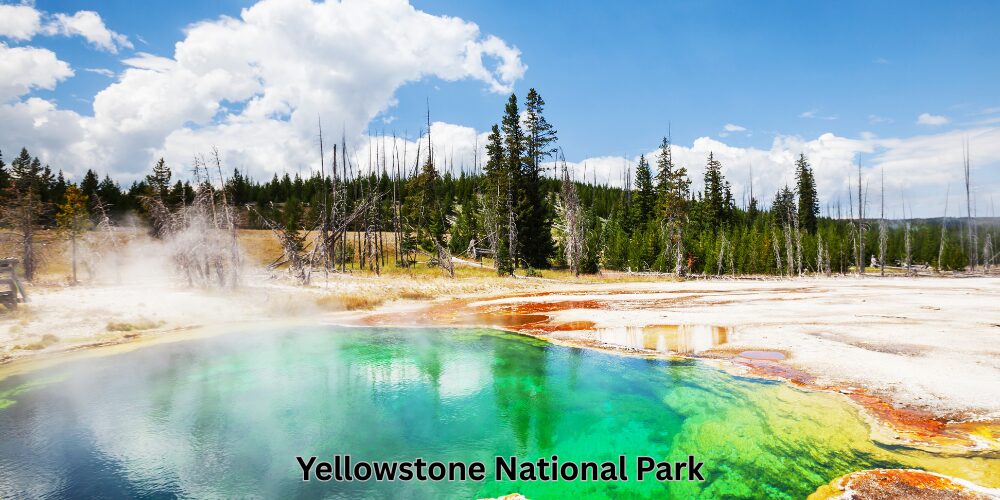Yellowstone National Park: You’ll be mesmerised by Earth’s Living Wonder
Tucked away in the wild, rugged corners of Wyoming, Montana, and Idaho lies Yellowstone National Park It is one of the most amazing natural destinations on Earth. Spanning over 2.2 million acres, it’s not only America’s first national park—established in 1872—but also one of its most awe-inspiring. It offers an unparalleled mix of geothermal phenomena, dramatic landscapes, and incredible wildlife.

Visiting Yellowstone feels like stepping into the pages of a fantasy novel—where steaming geysers erupt from the ground, rainbow-colored hot springs swirl with alien beauty, and herds of bison roam across vast valleys under endless skies. It’s not just a park—it’s a living planet, where the raw forces of Earth are constantly on display.
Click here for a 6-Day VIP Tour: Grand Canyon/Zion Canyon/Bryce Canyon/Grand Tetons/Yellowstone
A Supervolcano Beneath Your Feet
What makes Yellowstone unlike anywhere else? The answer lies just beneath the surface: a supervolcano—one of the largest active volcanic systems on the planet. The entire park sits atop a massive volcanic caldera formed by a cataclysmic eruption over 640,000 years ago. The heat from this underground behemoth fuels more than 10,000 hydrothermal features, making Yellowstone home to more geysers than anywhere else in the world.
The most famous, of course, is Old Faithful. This iconic geyser has been erupting reliably every 60 to 90 minutes for decades, shooting scalding water up to 180 feet into the air. Crowds gather around in hushed anticipation, and when the first jet of water bursts skyward, there’s always a collective gasp—no matter how many times you’ve seen it.
Nearby, Grand Prismatic Spring—the largest hot spring in the U.S.—looks almost unreal, with vivid rings of blue, green, orange, and red created by heat-loving microbes. Boardwalks curve around the steaming pool, allowing visitors to walk safely through this mesmerizing scene that feels more Martian than earthly.
Click here for a Yellowstone, Grand Teton,& Grand Circle Adventure: 7 Parks 9 Days
Landscapes That Defy Expectations
While Yellowstone is famed for its geothermal activity, its landscapes are just as spellbinding. The park is a mosaic of mountains, rivers, canyons, forests, waterfalls, and alpine meadows, each more dramatic than the last.
One of the most jaw-dropping sights is the Grand Canyon of the Yellowstone. Here, the Yellowstone River cuts through golden rock cliffs, plunging in two powerful waterfalls—Upper Falls and the thunderous Lower Falls, which drops 308 feet, almost twice the height of Niagara. Stand at Artist Point, and you’ll understand why painters and photographers have been captivated by this view for generations.
Then there’s Lamar Valley, often called “America’s Serengeti.” It’s one of the best places in the world to spot wild animals. At dawn or dusk, wolves, grizzlies, coyotes, and herds of bison and elk roam the grasslands, silhouetted against a backdrop of jagged peaks and sweeping skies. It’s a raw, untamed place where the modern world feels thousands of miles away.
Click here for a Private Upper Loop Grand Teton, Lower Loop Scenic & Wildlife 3 Day Tours
Wildlife That Roams Free
Yellowstone is not a zoo, and that’s part of its magic. More than 60 species of mammals and hundreds of bird and fish species call the park home, making it one of North America’s greatest wildlife sanctuaries.
Bison, the park’s shaggy symbol, often roam in massive herds across valleys and roads alike. Once nearly extinct, they now number in the thousands and are a living link to the Great Plains’ ancient past.
Click here to read about the most magical place on earth.
Then there’s the gray wolf, reintroduced in 1995 after a 70-year absence. Their return revitalized the ecosystem, helping control elk populations and allowing plant life and other species to flourish. Spotting a wolf in the wild is a rare but unforgettable experience, often made with the help of binoculars, patience, and early mornings.
Black bears and grizzlies also roam the park, especially in forested and mountainous areas. And then there are moose, pronghorn antelope, bald eagles, trumpeter swans, and even elusive mountain lions—all sharing this vast wilderness.

Adventure for Every Type of Explorer
Yellowstone is more than scenic drives and photo ops. It’s a paradise for hikers, campers, anglers, kayakers, and snowshoers. With over 900 miles of hiking trails, there’s something for everyone—from short strolls to multi-day backcountry treks.
Try hiking to Fairy Falls, where a 200-foot cascade crashes into a forest glade near Grand Prismatic Spring. Or explore Mount Washburn, offering panoramic views over the park and a good chance of spotting bighorn sheep.
In winter, Yellowstone transforms into a silent, snowy kingdom. Cross-country skiing, snowmobiling, and wildlife tracking are popular in this quieter season, and the landscape—frozen rivers, frost-covered pines, steaming geysers in the snow—is hauntingly beautiful.
Click here for a private 3 day aerial safari.
Historic Lodges and Rustic Charm
Staying in Yellowstone is an experience unto itself. The park offers everything from campgrounds to historic lodges. The Old Faithful Inn, built in 1904, is a masterpiece of rustic architecture, featuring a towering log lobby and crackling stone fireplaces.
Other favorites include Lake Yellowstone Hotel, with its elegant yellow façade overlooking the water, and Mammoth Hot Springs Hotel, located near surreal terraces of mineral-deposited springs. Staying inside the park means early access to wildlife-rich areas and the peaceful quiet of a Yellowstone morning, long before the crowds arrive.
Click here for a New York to Montauk fly fishing tour.
A Place of Reflection and Responsibility
Yellowstone is a place that inspires awe—but also humility. Here, the Earth reminds us that it is alive, powerful, and unpredictable. It’s a park that connects us not just to nature, but to the forces that shaped our world. Geysers and hot springs remind us of fire beneath the crust. Towering waterfalls speak to the power of water. Wildlife teaches us the importance of balance and respect.
But Yellowstone also comes with a responsibility. With millions of visitors each year, preserving its fragile ecosystems is more important than ever. Staying on trails, not feeding wildlife, packing out trash, and respecting nature are essential to keeping Yellowstone wild and wonderful for generations to come.
Click here for a day trip from Manhattan to Niagara Falls.
Conclusion: Where the Wild Still Rules
Yellowstone is more than a destination. It’s a sacred encounter with the Earth at its most primal. It invites us to unplug, look closer, breathe deeper, and remember what it means to be a small part of something much, much bigger.
Whether you visit for a day, a week, or a lifetime in memories, Yellowstone will leave its mark. Its geysers, valleys, and wildlife speak not only to the senses, but to the soul. In a world that moves faster by the minute, Yellowstone remains timeless—a land where the wild still rules, and where wonder waits around every bend.

